Paul Gilster's Blog, page 201
May 29, 2014
Sunset at Titan: The Problem of Haze
Given the high quality imagery returned by Cassini on an almost routine basis, it’s interesting to remember how little we knew about Saturn’s moon Titan back in November of 1980, when Voyager 1 made its closest approach to the planet. Think of the options the Voyager 1 team had in front of it. The craft could have been sent on to Uranus and Neptune, a trek Voyager 2 would later accomplish. It could have preempted New Horizons if, on a different trajectory, it had been sent to Pluto. But Titan had the allure of a thick atmosphere, making it an irresistible target.
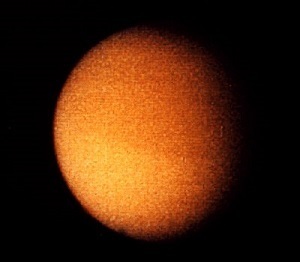
Deflecting Voyager 1 past Titan meant taking it out of the plane of the ecliptic, canceling the other two options, and the frustration of the Titan images the spacecraft returned is summed up in the view we see at the right, a moon whose surface is completely obscured. The visually impenetrable atmosphere was also found to be topped by a thick layer of haze. Learning about that atmosphere was hugely important for planetary science — the spacecraft detected methane, ethane, nitrogen and numerous organic compounds — but I can recall the sense of letdown in the general public upon seeing a featureless orange ball instead of a detailed surface like those of other gas giant moons Voyager 1 had seen.
Image: Titan as seen by Voyager 1’s cameras, which could not penetrate the deep haze of organic aerosols. Credit: NASA.
Titan’s murk would eventually be penetrated by Cassini’s instruments and, of course, the Huygens lander that descended into the atmosphere for its long parachute drop to the surface. But the haze continues to be a major part of Titan’s story, and as this JPL news release points out, its effects can be useful even in terms of how we learn about exoplanets. For Cassini is in position to witness Titan’s sunsets, solar occultations that mimic what we observe when collecting spectra of an exoplanet’s atmosphere as its star’s light passes through it.
The technique is called transmission spectroscopy. As the star’s light passes through the atmosphere of an exoplanet in transit, some of that light is absorbed by the atmosphere, giving us a spectrum that can tell us about the atoms, molecules and grains found there. Knowing that clouds and high-altitude hazes like those on Titan are not uncommon in our own system, we can assume that many exoplanets will have them as well. That means that understanding their effects is key to describing the limits of this transit technique.
A team led by Tyler Robinson (NASA Ames) used four Cassini observations of Titan made between 2006 and 2011 using the spacecraft’s visual and infrared mapping spectrometer instrument (VIMS). The work, described in Proceedings of the National Academy of Sciences, then compared the complex effect of hazes to exoplanet models and observations. The result: Hazes like those on Titan provide a severe check on what we can learn from transmission spectroscopy, and may give us information only about the planet’s upper atmosphere. That’s a level that on Titan would be 150 to 300 kilometers above the surface.
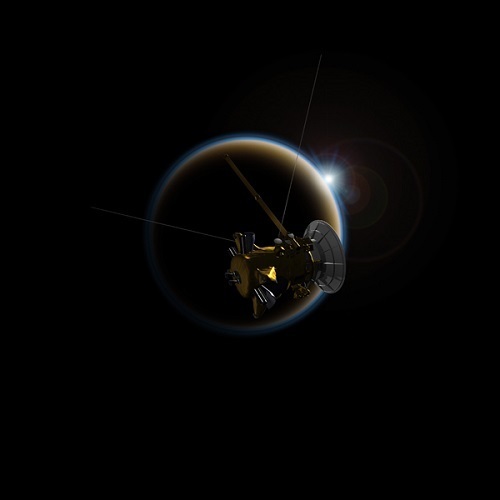
Image: Using data collected by Cassini’s Visual and Infrared Mapping Spectrometer, or VIMS, while observing Titan’s sunsets, researchers created simulated spectra of Titan as if it were a planet transiting across the face of a distant star. The research helps scientists to better understand observations of exoplanets with hazy atmospheres. Credit: NASA/JPL.
We also learn that Titan’s hazes affect shorter, bluer wavelengths of light more strongly than other colors, a result not anticipated by previous studies of exoplanet spectra, which assumed that hazes affected all colors of light in more or less the same way.
“People had dreamed up rules for how planets would behave when seen in transit, but Titan didn’t get the memo,” said Mark Marley, a co-author of the study at NASA Ames. “It looks nothing like some of the previous suggestions, and it’s because of the haze.”
Using Titan as a close-up stand-in for a distant exoplanet helps us see how much an effect haze can have. In Titan’s case, we would be looking at layers far above the densest and most complex layers of its atmosphere. All of these complicated effects have to be worked out as we extract the signature of an exoplanet’s atmosphere, a challenge that is clearly formidable. The good news is that techniques like these can be applied to the atmospheres of planets in our own Solar System just as they were at Titan to help us develop more accurate, workable models.






May 28, 2014
Proposed Europa/Io Sample Return Mission
I love a long journey by car or rail, but not by airplane. Back in my flight instructing days, I used to love to take a Cessna 182 on a long jaunt, but these days the flying I do means sitting in the cheap seats in the back of a gigantic jet and suffering the various indignities of security checks, long lines and tightly packed quarters. Hence my 1000 mile rule: If the trip is less than that distance, I’ll drive it or look for a rail connection. My recent trip back to the Midwest reminded me how much I enjoy seeing the scenery at my own pace and having plenty of time to think.
One of the things I thought about was how to extract maximum value from spacecraft. A decade or so ago, JPL’s James Lesh explained to me how the signal from a distant probe passing behind a planet would be affected by that planet’s atmosphere. An elementary way to do atmospheric science! I’ve mused ever since about how to do complicated things with existing resources and how to put technology in the right place for bonus information returns. All that led to thoughts about our prime astrobiology targets in the outer system: Europa and Enceladus.
Earlier this month I wrote about Lee Billings’ Aeon Magazine essay Onward to Europa, in which he speculated about the the possibility of exploring what is beneath the Europan crust. A mission like this could be done without actually descending to the surface and penetrating the ice. Billings noted that the Hubble Space Telescope has detected water vapor, estimated at about 7000 kg of water per second, being blown into space from the surface. Europa’s high-radiation environment is challenging even for a robotic lander, but maybe we could fly through the Europan plume to sample the moon’s chemistry and possibly even detect signs of biological activity. The essay Ship of Dreams in Astrobiology Magazine speculates on the proposed Europa Clipper mission flying through the plumes, but budget issues could make the $2.1 billion Clipper too expensive.
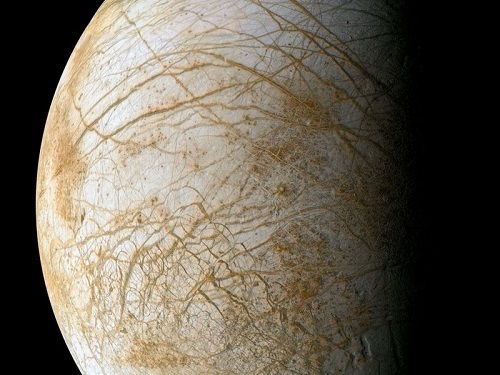
Image: A prime target for astrobiology, Europa (as imaged here by the Galileo spacecraft) is the subject of multiple mission concepts. Credit: NASA/JPL/Ted Stryk.
Similar ideas have surfaced about Enceladus, with an eye toward flying a complicated mission on a tight budget indeed. Consider the Life Investigation for Enceladus mission concept, championed by Peter Tsou (Sample Exploration Systems). I read more about this one in an essay by Andrew LePage on his Drew ex machina website. LePage, a physicist and writer who serves as senior project scientist for Visidyne Inc. in Boston, notes that the LIFE mission would use an aerogel collector like the one NASA used in the Stardust sample return mission to return cometary dust in 2006. Some concepts also call for sample return from Saturn’s E-ring, thought to be made up of particles originally from Enceladus’ geysers.
All this came into the public eye last summer at the Low-Cost Planetary Missions Conference (LCPM-10) at Caltech, where Tsou laid out a 15-year mission that would launch in the early 2020s, reaching Saturn in May of 2030 after a series of gravity assists past Venus and the Earth. LIFE would use close passes by Titan to alter its orbit, allowing multiple low-speed approaches through the Enceladus geyser region above the moon’s south pole. At speeds slower than Stardust’s encounter with Comet Wild 2, the Enceladan material should be better preserved when captured. LIFE would then use Titan for further gravity assists followed by a return to Earth in 2036.
I love the concept as much as I love extracting atmospheric science from communications signals. The cost excluding launch might be kept as low as $425 million. The potential gain is high. LePage likes it, too, and goes on to suggest not just improvements to the Enceladus idea, but a different sample return mission that would bring back materials from both Europa and Io. The mission could launch as early as 2021, with rendezvous with Jupiter in October of 2025. LePage lays out the basics: An elongated orbit to avoid the worst of Jupiter’s radiation belts, gravity assists from Europa, Ganymede and Callisto, multiple low-velocity encounters with the Europan polar plumes and gathering of plume materials with the aerogel collector.
Then figure several months of observation to scope out a target on Io, then a close pass by the moon to sample one of its volcanic plumes, a scary swing through the most intense regions of Jupiter’s radiation belts, but one of only two passes through the worst of them (the other being at insertion into orbit around Jupiter). Re-entry to Earth’s atmosphere would occur in 2030. It’s a mission concept with intriguing resonance with the LIFE mission and builds on the same technologies. Says LePage:
While a lot more work is required to flesh out the details of a Europa-Io sample return mission (especially more information on the nature of Europa’s purported plumes), at first blush it does appear to be feasible using the same hardware proposed for the LIFE mission to Enceladus employing readily available launch vehicles. This proposed mission also nicely complements the investigations of the LIFE mission by returning samples from yet another set of plumes on a potentially life-bearing moon with the added bonus of sampling volcanic material from a second target of keen interest to planetary scientists – Io, the solar system’s most volcanically active world.
The nine-year mission LePage envisions is substantially shorter than the 15-year LIFE mission, and could be completed about the time that LIFE arrived at Saturn. This would have been a great concept to mull over on my trip, and I wish I could have read about it before I left. I’d love to see follow-up work, particularly on that white-knuckle pass by Io. The essay continues:
For minimal additional costs (i.e. a second spacecraft and launch vehicle along with the incremental cost increase of running two missions in parallel), this scientifically interesting mission could be flown in parallel with LIFE and greatly increase its total science return. And it could probably do so within the Administration’s proposed billion dollar price cap for a Europa mission.
Given that we’re now dealing with budget proposals that confine a NASA Europa mission to under a billion dollars, the sample return mission to Europa even without the Io component offers a profoundly interesting science return, and I like the synergies with the more fully developed LIFE concept. In any case, we have two highly intriguing astrobiology targets that are conveniently venting material into nearby space, making landing on the surface — much less trying to penetrate fissures or drill through thick ice — unnecessary at this stage of our investigations. What we learn from such missions could well determine how we press ahead with later, more complex missions that would demand operations on or below the ice.






May 27, 2014
New Horizons: The KBO Hunt Continues
Of the many interesting questions Nick Nielsen raised in last Friday’s post, the one that may be most familiar to the interstellar community is the question of potential breakthroughs. What happens if an unexpected discovery in propulsion makes all the intervening stages — building up a Solar System-wide infrastructure step by step — unnecessary? If we had the kind of disruptive breakthrough that enabled starflight tomorrow, wouldn’t the society that grew out of that capability be fundamentally different than one in which starflight took centuries to achieve?
I was mulling this over yesterday when I read Pluto-bound Probe Faces Crisis, a short article in Nature that several readers had passed along. With the New Horizons probe pressing on for a close-pass of Pluto/Charon next year, the assumption all along has been that it would make a course correction after the encounter to set up a flyby of a Kuiper Belt Object (KBO). The trick there is that the New Horizons team is running out of time to find the right KBO. The sense of urgency is revealed in the fact that mission scientists have asked for 160 orbits of observing time on the Hubble instrument, which the article calls a ‘rare request’ for an already operational mission.
Alexandra Witze sums up the reason for the delay in identifying a target in the Nature story:
In theory, project scientists should have identified a suitable KBO long ago. But they postponed their main search until 2011, waiting for all the possible KBO targets to begin converging on a narrow cone of space that New Horizons should be able to reach after its Pluto encounter. Starting to look for them before 2011 would have been impossible, says [mission co-investigator Will] Grundy, because they would have been spread over too much of the sky.
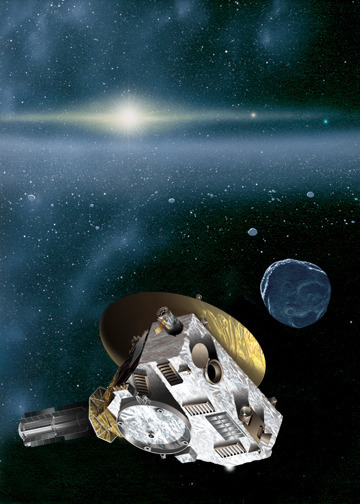
The Voyagers, Galileo, New Horizons and their ilk represent a familiar evolutionary model of our expansion into the outer Solar System as opposed to the kind of disruptive breakthrough Nick was speculating about. In this model, we learn from mission to mission, making each more capable, adding technologies that can get instruments to their destinations at a faster clip. We can’t predict disruptive technologies, but we can see a rational line of development of current tech as we tune up our deep space craft, one in which the ongoing New Horizons issues play a major role.
Image: Artist’s impression of the New Horizons spacecraft encountering a Kuiper Belt object. The Sun, more than 4.1 billion miles (6.7 billion kilometers) away, shines as a bright star embedded in the glow of the zodiacal dust cloud. Jupiter and Neptune are visible as orange and blue “stars” to the right of the Sun. Although you would not actually see the myriad other objects that make up the Kuiper Belt because they are so far apart, they are shown here to give the impression of an extensive disk of icy worlds beyond Neptune. Credit: Johns Hopkins University Applied Physics Laboratory/Southwest Research Institute (JHUAPL/SwRI)
The next year is going to be filled with New Horizons news and, let’s hope, a resolution of the KBO issue. Fifty new KBOs have thus far been identified in the hunt, which has used the resources of the 8.2-metre Subaru Telescope in Hawaii and the 6.5-metre Magellan Telescopes in Chile. None, as it turns out, is close enough to New Horizons’ trajectory to make it feasible given the constraints on the spacecraft’s ability to maneuver. And as I’ve mentioned in these pages before, the search field is tricky, looking directly out along the plane of the galaxy, which means the faint signature of a KBO is readily lost in the starfield. The good news is that by adding Hubble into the mix — and a decision on this won’t be reached until June 13 — the chances of a detection soar over what they would be using ground-based telescopes alone.
Make no mistake, even a long-distance observation of a KBO from New Horizons’ 21-centimeter telescope would trump what we can see from Earth orbit, but obviously a much closer look at a primordial survivor from the Solar System’s early history would be preferable. We wait and hope for the best. Meanwhile, we in the interstellar community should be tracking this mission with great interest. New Horizons is pushing into terra incognita with instruments designed for the job, and represents, as Michael Michaud recently commented to me, a more relevant transition to our deep space future than the Voyager spacecraft. It should energize our designs for future craft that will push further into the Kuiper Belt and beyond. This incremental model works, and if along the way a disruptive breakthrough occurs, then so much the better.






May 23, 2014
How We Get There Matters
Nick Nielsen’s new essay follows up his speculations on interstellar infrastructure with a look at the kind of starships we might one day build. The consequences are profound. What if we master interstellar technologies without needing the Solar System-wide infrastructure many of us assume will precede them? A civilization’s interstellar ‘footprint’ would be radically altered if this is the case, and evidence of mega-engineering among the stars sharply constrained. Then too, how we view what is possible could be transformed by breakthroughs in biology and longevity, all part of the mix as we look at what Nick calls ‘undetermined nodes in future history.”
by J. N. Nielsen

In my previous Centauri Dreams post, The Infrastructure Problem, I sought to make a distinction between fundamentally different forms that a spacefaring civilization might take, one tending toward primarily planetary-based infrastructure, and another tending toward primarily space-based infrastructure. I am always pleased by the insightful comments I receive from Centauri Dreams readers, which never fail to spur me on to further (hopefully improved) formulations. [1] This last post was no exception. I was particularly interested in a comment by William Blight:
“A lot of ifs in this author’s presentation. Large scale industrialization of the moon for power and materials using automation and robotics for rapid bootstrapping is probably the best method for developing a powerful space infrastructure. Colonizing Mars will accelerate the development of propulsion systems. I don’t see how speculation in regard [to] Alcubierre drives has real connection to the development of near-term, space-based industry.”
This comment has helped me to understand the limitations of my exposition. There were a lot of “ifs” in my presentation. Of course what I wrote was highly speculative, as all contemporary writing on interstellar travel must be, but it was speculation with a purpose, and I am concerned that my purpose was not sufficiently clear.
We cannot see the future in detail, but we can distinguish broad patterns of development, just as we can see broad patterns of development in the past, if we look to the past for its overall lessons and not for the ideographic detail that fascinates biographers. Every “if” represents an undetermined node in future history, where under conditions of constraint we may be forced to choose between mutually exclusive alternatives, while given an open future somewhat less subject to constraint (e.g., a future in space where energy and materials are cheaply available, if only we can keep ourselves alive in space long enough to exploit them), an undetermined node represents a point of bifurcation where different communities will take different directions. These are the patterns I am trying to explicate.
Interstellar travel represents an undetermined node in future history, and we do not yet know all the constraints that will bear upon starships once we build them. It would be a mistake to think of interstellar travel in all-or-nothing terms, i.e., either we have the technological capacity or we don’t, because this technological capacity will be developed little-by-little, step-by-step. When an interstellar voyage comes at great personal cost (in time, money, opportunity cost, inconvenience, and discomfort), only a trickle of individuals will possess both the resources and the overwhelming desire to go. As the journey declines in the personal costs it demands, it will appeal to greater numbers of individuals, until the trickle eventually becomes a flood. The relative ease or lack thereof in interstellar travel will be a function of the technologies employed, so that the technologies we will eventually use to travel to the stars will shape the historical structure of that travel, and of the spacefaring civilization that undertakes interstellar travel. In other words, how we get there matters.
There is no more compelling argument for the fact that how we get there matters than the present dependency of the transportation network, and indeed of the whole of industrial-technological civilization, on fossil fuels. We all know that the geopolitics of fossil fuels has decisively shaped the world we live in, and that if some other technology, a non-fossil fuel technology, were the basis of global energy markets, the world today would be a different place.
Future technologies of interstellar flight will shape spacefaring civilization as profoundly as fossil fuels shape our world. Until particular technologies are developed and put into practice, we cannot know which will prove practicable and which will be mere curiosities of little utility, yet by reducing the possibilities for starships down to a few broadly-defined classes, we can sharpen the focus of how we think about the potential niches for spacefaring civilization. Consider this division of potential interstellar transit technologies into four classes:
Class 0: Very long term interstellar travel, beyond the practicability of generational starships. Another way to think of this would be in terms of interstellar travel on geological time scales.
Class 1: Generational starships, i.e., starships that would require from one to several generations (measured in ordinary human life spans) in order to reach their destination.
Class 2: Interstellar transit within the life-span of an individual, measured in months, years, or decades.
Class 3: Rapid interstellar transit on the order of global transportation today, measurable in hours or days.
This is a very rough and provisional division, and the reader should place no emphasis on the particular divisions I have made or the particular technologies that I cite, but only on the idea that we can divide potential interstellar transit technologies into broadly distinct classes. (The possibilities for interstellar drives are parallel to the possibility of some other industrial-technological civilization in the galaxy, not identical to us, but differing in terms of countless contingencies. The important point is not the identity of a particular technology or civilization, but the capacity it has to serve a particular role.) In each of these classes we can identify a series of technological developments that could shorten the voyage, but the voyage on the whole would remain roughly within the parameters of the classes sketched above, so that the upper edge of class 0 touches the lower edge of class 1, and so forth.
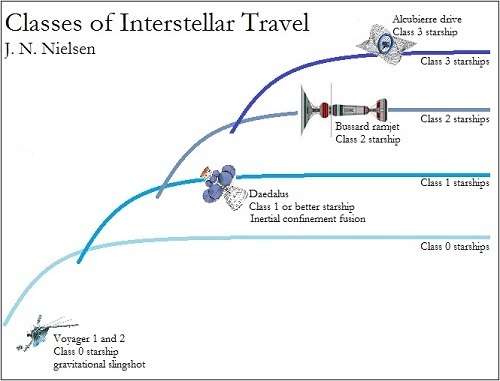
Image: Categories of starships. Credit: Nick Nielsen.
The other variables that enter into the equation of interstellar travel—longevity and destination choice among them—also admit of many possible solutions. Human life might be extended by many different technological means (incremental improvements in the life sciences, regenerative medicine, suspended animation, etc.), or even someday by the simplest of biological means. [2] And once having met the minimum interstellar threshold for a destination, interstellar travelers will have a wide choice of destinations that will affect the length of the trip. A Class 1 starship that would be a generational ship for human beings with an average life-span of today could be considered a Class 2 starship if life spans were considerably lengthened or if suspended animation technology proved to be practicable. The point here is that there is more than one way to approach the problem, and how we solve the problem matters to the kind of spacefaring civilization we eventually build.
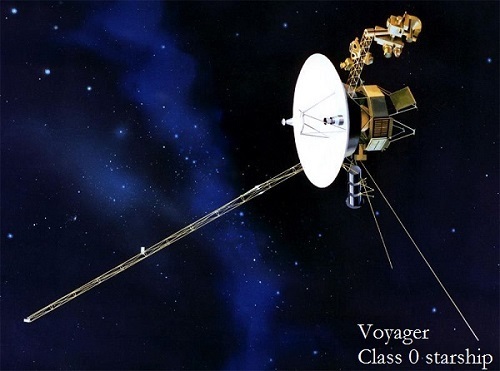
The gravitational slingshot technology employed to send the Voyager spacecraft on interstellar trajectories could be further extrapolated with gravitational slingshots around other star systems, which might raise the velocity of a spacecraft to one percent of the speed of light. [3] This could be much faster than the Voyager spacecraft are traveling at present, but still clearly constituting class 0 interstellar transit. Were we to develop biological reconstitution technology that could remain functional for thousands of years, and we launched this on a class 0 starship (like Voyager, i.e., something that we could build with known technologies), we would then begin the era of human interstellar travel.
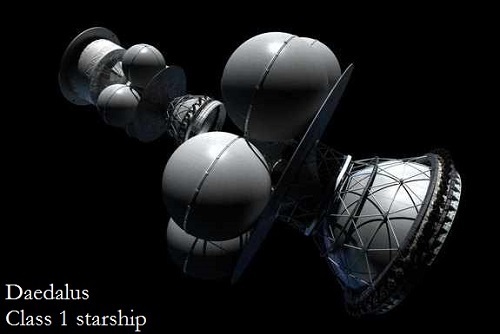
Image: The Daedalus starship. Credit: Adrian Mann.
A light sail might be at the upper edge of class 0 or the lower edge of class 1 interstellar travel, while a light sail further propelled by a laser might approach the upper edge of class 1. The Daedalus starship design should be considered a class 1 starship, though incremental improvements in fusion technology might boost it to the lower edge of class 2 starships. More exotic drives such as matter-antimatter reaction might qualify as class 2 starships, perhaps attaining the status of a 1G starship (such as I discussed in Stepping Stones Across the Cosmos), which would allow travel throughout our galaxy within an ordinary human lifespan, though relativistic effects would mean that accelerated communities would be temporally disjointed from non-accelerated communities. Even more exotic propulsion systems – whether the Alcubierre drive, the technology to manufacture wormholes at will, or other possibilities not imagined today – would qualify as class 3 starships that would convey us between stars as readily as jet aircraft convey us between continents today.
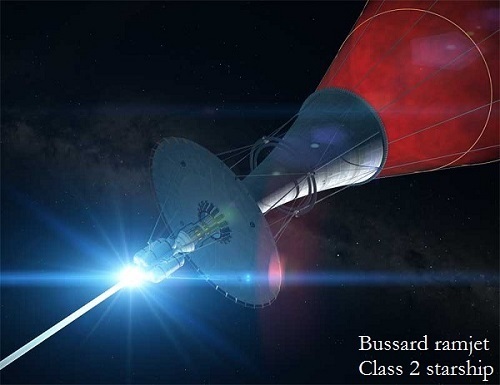
Image: The Bussard ramjet design. Credit: Adrian Mann.
The technological developments that could shorten the voyage of a particular class of interstellar travel represent technological succession, just as does the sequence of classes itself (which constitutes technological succession on a greater order of magnitude). In many historical cases of technological succession we see the gradual development of improved technologies, as with automobiles or integrated circuits. When technological succession happens in this way it is largely predictable, but technological succession is sometimes disruptive rather than a smooth progression. In the middle of the twentieth century many assumed that human spaceflight would be attained by the gradual improvement in supersonic flight. However, hypersonic flight has proved to be a difficult engineering challenge, and we have not yet mastered it, but chemical rocket technology leapfrogged supersonic flight and put human beings in orbit and on the moon before the gradual technological succession of improving supersonic to hypersonic to escape velocity technology could catch up. It still hasn’t caught up.
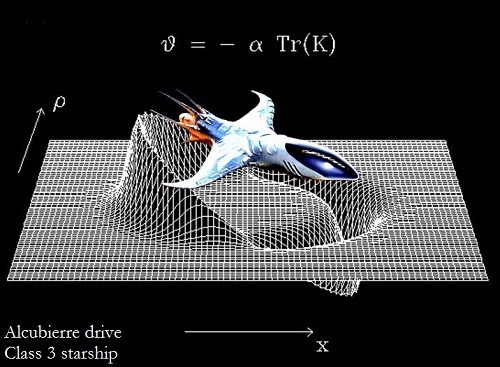
Image: Conceptualizing the Alcubierre drive. Credit: Anderson Institute.
Gradual technological succession would take place within classes of starships; disruptive technological succession would occur when one class of starship supersedes another. If we launched a class 0 starship with reconstitution technology on board, and a hundred years later (or even a thousand years later) developed class 2 starship technology, the class 2 starships would overtake the class 0 starship in a way not unlike how jet aircraft overtook propeller-driven aircraft, and chemical rockets overtook jet aircraft. If class 2 starship technology disruptively precedes practicable class 0 or class 1 starship technology, the entire era of generational starships, class 0 and class 1, will be bypassed.
We are not in a position to judge the relative success of technologies only now imagined, but once we have in place a way to differentiate between entirely different classes of starships, we can speak in terms of the kind of spacefaring civilization emergent from any technology capable of building a class x starship. What the particular technology will be is indifferent to our problem; any class x starship will do. With these considerations in mind, I can return to the point of my previous post, The Infrastructure Problem.
To restate the infrastructure problem, any sufficiently advanced class 2 starship, or any class 3 starship, that can be constructed exclusively with terrestrial infrastructure would yield a spacefaring civilization that possessed only a minimal space-based infrastructure. A spacefaring civilization with minimal space-based infrastructure would be unlikely to engage in megastructure engineering and would thus have a much more modest “footprint” in the cosmos than a Kardashevian supercivilization.
If contemporary terrestrial industrial-technological civilization continues in its present development (i.e., if it does not stagnate), and if it is not destroyed, our sophistication in science and technology will likely improve to the point at which we can build at least an advanced class 2 starship (if not a class 3 starship) and fly directly from the surface of Earth to other worlds – an SSTS spacecraft (single-stage to stellar), if you will.
Such a trajectory of development creates its own great filter, as the ongoing existential viability of a terrestrial-based industrial-technological civilization is contingent upon passing through an extended window of vulnerability when we have the technological capacity to destroy ourselves (intentionally through warfare or unintentionally through the toxic byproducts of industrialism) without bothering to exploit the technology we also possess to establish a rudimentary spacefaring civilization with multiple independent centers of civilization tolerant of local extinction, where “local” means “terrestrial.”
Ever since the advent of the Space Age in the middle of the twentieth century there have been ambitious plans to rapidly expand the human presence in space, from the “Collier’s” space program (Man Will Conquer Space Soon!) to O’Neill colonies. To date, none of these ambitious plans have come to fruition, although our technology is considerably more advanced than when humanity first entered space. Only superpower competition has proved to be a sufficient spur to a major space effort. It does not appear, then, that humanity is an “early adopter” of existential risk mitigation by way of space settlement; we are not moving in the direction of creating a spacefaring civilization predicated upon a robust space-based infrastructure.
The trajectory of development that humanity has not taken represents a possibility, a niche for spacefaring civilization, that some other intelligent species might have taken, or might yet take, and the result of taking this space-based infrastructure path of development would be a spacefaring civilization of a structure disjoint from that characterizing spacefaring civilization of a primarily Earth-based infrastructure. [4]
If none of the technologies that would make possible advanced class 2 or class 3 starships could be made sufficiently compact that they could be built on Earth and boosted into space, then a civilization would be forced into a choice between remaining stranded within its solar system or eventually building a space-based infrastructure in order to build a starship (this is an instance of “conditions of constraint” resulting in mutually exclusive alternatives mentioned above). For example, a class 1 starship like Daedalus could not be constructed without space-based infrastructure.
I am not an engineer. I will not be designing any starships. Others will design starships, and others will formulate the ideas that are eventually translated into technologies and designs for interstellar flight. As I see it, these technologies are variables in the equation of the large scale structure of any spacefaring civilization. If there is no solution to the equation of spacefaring civilization, given some particular value for the variable of feasible interstellar travel, then we try to solve it again using a different variable. If there are no solutions at all, then we are stuck in our own solar system and the same is true of any other spacefaring civilization that emerges on any other world. [5]
What interests me is the large scale structure of civilization of any possible spacefaring civilization. I assume if a spacefaring civilization emerges more than once in our universe, these multiple spacefaring civilizations may take multiple paths of development (cf. note [4]), or they may converge upon some particular path of development to spaceflight if the parameters of possible spacefaring technologies are quite narrow. Different solutions to the equation for spacefaring civilizations yield different large scale structures of that civilization. If there is only one solution to the problem, i.e., only one technology for practicable interstellar travel, then this will exercise a strongly convergent force on the structure of any spacefaring civilization and is an equally strong condition of constraint.
From these considerations another typology begins to emerge:
1. There is no solution to the problem of interstellar travel. (Cf. note [5])
2. There is a single solution to the problem of interstellar travel, where “single solution” means only one practicable class of starships. A single class of practicable starships still admits of the possibility of technological succession within this class, so that interstellar civilizations might admit of different stages of development in their mastery of the single practicable interstellar technology.
3. There are multiple solutions to the problem of interstellar travel, so that multiple classes of starships are technologically practicable.
In the first case, all spacefaring civilizations are confined to their star system of origin. We already know this to be false, because the Voyager spacecraft are in interstellar space at this moment. However, if one redefines interstellar travel as to exclude class 0 starships, then humanity remains confined within our solar system in this first case. In the second case, spacefaring civilizations are constrained by technology to the choice of becoming an interstellar civilization or not, but all interstellar civilizations will be constrained by the parameters of the single practicable interstellar technology. In the third case, if a spacefaring civilization achieves interstellar travel, it may do so by multiple means, and interstellar civilizations will be differently constrained according to the technology or technologies they develop (in addition to other factors). [6]
Notes
[1] All of the comments I have received are greatly appreciated, and I regret that I have not responded to each comment individually, but when the reader sees the extent to which this response to a comment runs, it may perhaps be understandable.
[2] The point I am trying to make in this present argument, how we get there matters, applies equally to the technologies of transhumanism, which will not be separate from interstellar travel but will interact with the human exploration of space. Whether human beings are able to travel to distant stars because of greatly extended life-spans, or suspended animation, or reconstitution, how we get to an extended life-span matters, because each technology interacts differently with the individual life and the socioeconomic structures within which the individual finds a place. Similarly, each interstellar propulsion technology interacts differently with the individual life, making use of such propulsion technologies and the socioeconomic structure within which the individual finds a place.
[3] In a post titled, “Galactic Grand Tours, and strengthening Fermi’s Paradox” on the Well-Bred Insolence blog, Duncan Forgan writes, “…if a probe carries out a series of slingshots as it tours the Galaxy, the probe can be accelerated to approximately 1% of the speed of light without shipping enormous amounts of fuel (bear in mind Voyager 1 is travelling at 0.003% of lightspeed).”
[4] An alien civilization might take a different technological path due to different intellectual endowments. It may be that a science and technology, which remains opaque to the kind of minds that we have, will be readily mastered by an intelligent species with a different kind of mind, and vice versa. Bertrand Russell provided an imaginative example that serves as a kind of thought experiment in this respect:
We are certainly stimulated by our experience to the creation of the concept of number – the connection of the decimal system with our ten fingers is enough to prove this. If one could imagine intelligent beings living on the sun, where everything is gaseous, they would presumably have no concept of number, any more than of “things.” They might have mathematics, but the most elementary branch would be topology. Some solar Einstein might invent arithmetic, and imagine a world to which it would be applicable, but the subject would be considered too difficult for schoolboys. (Bertrand Russell, The Philosophy of Bertrand Russell, edited by Paul Arthur Schilpp, Evanston and Chicago: Northwestern University, 1944, p. 697.)
These considerations apply both to the large-scale structure of a spacefaring civilization as well as the particular technologies any such civilization pursues in the attempt to master interstellar flight.
[5] This is the position of Peter D. Ward and Donald Brownlee (best known for their book Rare Earth: Why Complex Life is Uncommon in the Universe): “The starships of TV, movies, and novels are products of wishful thinking. Interstellar travel will likely never happen, meaning we are stranded in this solar system forever. We are also likely to be permanently stuck on Earth. It is our oasis in space, and the present is our very special place in time. Humans should enjoy and cherish their day in the Sun on a very special planet… Our experience on Earth is probably repeated endlessly in the cosmos. Life develops on planets but it is ultimately destroyed by the light of a slowly brightening star. It is a cruel fact of nature that life-giving stars always go bad.” (The Life and Death of Planet Earth: How the New Science of Astrobiology Charts the Ultimate Fate of Our World, New York: Henry Holt and Company, 2002, pp. 207-208). In this case, the possibility of a large scale spacefaring civilization does not disappear (though Ward and Brownlee explicitly exclude this possibility also), but it takes on a different form, and any communication between advanced industrial-technological civilizations would have to come about by way of SETI and METI. The impossibility of interstellar travel is entirely compatible with megascale engineering within our own solar system, which megastructures could include the building of vast EM spectrum communications antennae capable of communicating across interstellar distances.
[6] A further distinction could be made in the third case between “more than one solution to the problem of interstellar travel exists” (i.e., at least two solutions exist to the problem of interstellar travel), and, “all classes of interstellar travel are technologically practicable.”






May 22, 2014
Thoughts on a Spacecraft’s Rebirth
According to a recent NASA news release, the agency has never before signed the kind of agreement it has made with Skycorp, Inc., a Los Gatos, CA-based firm that will now attempt contact with the International Sun-Earth Explorer-3 (ISEE-3) spacecraft. You’ll recall that this is the vehicle that scientists and space activists alike have been talking about resurrecting now that, having completed its studies of the solar wind in 1981 and later comet observations, it is making its closest approach to the Earth in more than thirty years (see ISEE-3: The Challenge of the Long Duration Flight).
According to its website, Skycorp is in the business of bringing “…new technologies, new approaches, and reduced cost to the manufacture of spacecraft and space systems.” Founded in 1998, the company signed a Space Act Agreement with NASA for the use of the International Space Station in 1999, and qualified the first commercial payload used in the filming of a television commercial (for Radio Shack) in 2001. In addition to its ISEE-3 involvement, Skycorp is now working on an orbit servicing system (for Orbital Recovery Corporation) and the design of lunar surface systems with NASA.
The document NASA has now signed is a Non-Reimbursable Space Act Agreement (NRSAA) with Skycorp that involves not just contact with the ISEE-3 spacecraft but, possibly, command and control over it. ISEE-3 will near the Earth this August, and the agreement lays out the variety of what NASA describes as “technical, safety, legal and proprietary issues” that will need to be addressed before contacting and re-purposing the spacecraft can be attempted.
“The intrepid ISEE-3 spacecraft was sent away from its primary mission to study the physics of the solar wind extending its mission of discovery to study two comets.” said John Grunsfeld, astronaut and associate administrator for the Science Mission Directorate at NASA headquarters in Washington. “We have a chance to engage a new generation of citizen scientists through this creative effort to recapture the ISEE-3 spacecraft as it zips by the Earth this summer.”
It’s hard not to get excited about the prospects here. The ISEE-3 Reboot Project works with a spacecraft that, although inactive for many years, still contains fuel and probably functional instruments. Of course, ISEE-3′s reactivation will be handled remotely, but in the 1960s this would have made a great scenario for a short story in one of the science fiction magazines. In that era, ideas like in-space repair of satellites and salvage and re-use of older equipment by human crews were concepts made fresh by the sudden progress of the manned space program. After all, we were doing space walks!
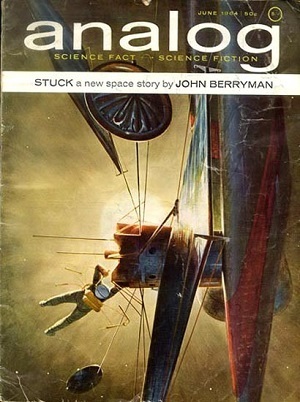
I’m remembering “The Trouble with Telstar,” a 1963 story by John Berryman (the SF writer, not the poet) that brought home to readers what would be involved in maintaining a space infrastructure. In the editorial squib introducing it, John Campbell wrote: “The real trouble with communications satellites is the enormous difficulty of repairing even the simplest little trouble. You need such a loooong screwdriver.” It was a lesson we’d learn again in spades with the Hubble repairs. Berryman, a writer and engineer who died in 1988, followed up with “Stuck,” another tale of space repair that inspired the gorgeous John Schoenherr cover at the right.
Fortunately, the reactivation of ISEE-3 isn’t a hands-on repair job and we can attempt to salvage this bird from Earth. Current thinking is to insert the spacecraft into an orbit at the L1 Lagrangian point, at which time the probe would be put back into operations. In this sense, ISEE-3 is an interesting measure of our ability to build long-term hardware. Like Voyager, the diminutive spacecraft was never intended for activities over this kind of time-frame, but new operations do appear possible. Everything depends, of course, upon the satellite’s close approach this summer, for if communications cannot be established, it will simply continue its orbit of the Sun.
So we have a “citizen science” program hard at work on a novel problem, with the help of the agency that put the spacecraft into motion all those years ago. Any new data from a re-born ISEE-3 is to be broadly shared within the science community and the public, offering a useful educational tool showing how we gather data in space and disseminate the results. We’ll also learn a good deal about how spacecraft endure the space environment over a span of decades, information that will contribute to our thinking about future probes on long missions and potentially extendable observation windows.
Not bad for a satellite sent out over three decades ago to study how the solar wind can affect satellites in Earth orbit and possibly disrupt our sensitive technological infrastructure. I’m now wondering whether there are other spacecraft out there that might be brought back to life, and reminded that when we build things to last, we can discover uses that the original designers may not have dreamed of. That’s a lesson we’ll want to remember as we create mission concepts around any new space hardware.






May 21, 2014
Exomoons: A New Technique for Detection
A friend asked me the other day whether my interest in exomoons — moons around exoplanets — wasn’t just a fascination with the technology of planet hunting. After all, we’ve finally gotten to the point where we can detect and confirm planets around other stars. An exomoon represents the next step at pushing our methods, and a detection would be an affirmation of just how far new technology and ingenious analysis can take us. So was there really any scientific value in finding exomoons, or was the hunt little more than an exercise in refining our tools?
I’ve written about technology for a long time, but the case for exomoons goes well beyond what my friend describes. We’ve found not just gas giants but ‘super-Earths’ in the habitable zones of other stars, and it’s a natural suggestion that around one or both classes of planet, an exomoon might he habitable even if the parent world were not. It’s a natural assumption that moons exist around other planets elsewhere as readily as they do around the planets of our own Solar System, and given the sheer number of planets out there, the prospect of adding potential sites for life — perhaps more common sites than habitable planets themselves — is irresistible.
Then in catching up with work after my recent trip, I noticed René Heller’s work on the exomoon question, as reported in Astrobiology Magazine. Heller (McMaster University, Ontario) is proposing a new method of detection that involves the particular eclipsing effect of moons during the kind of transit studies that Kepler has provided so much data on. What is striking here is that if Heller is right, we may be able to detect not just moons several times larger than Ganymede — this is where the current state of the art seems to be — but moons much smaller still, on the scale of the moons we find in our own Solar System.
Heller’s paper, recently published in The Astrophysical Journal, picks up on further scientific advantages in studying exomoons. Such objects can offer us insights into how exoplanets formed. Consider this (internal references omitted for brevity):
The satellite systems around Jupiter and Saturn, for example, show different architectures with Jupiter hosting four massive moons and Saturn hosting only one. Intriguingly, the total mass of these major satellites is about 10-4 times their planet’s mass, which can be explained by their common formation in the circumplanetary gas and debris disk…, and by Jupiter opening up a gap in the heliocentric disk during its own formation… The formation of Earth is inextricably linked with the formation of the Moon…, and Uranus’ natural satellites indicate a successive ‘collisional tilting scenario’, thereby explaining the planet’s unusual spin-orbit misalignment.
And so on. Between astrobiology and planet formation, I’d say there is plenty of reason to be interested in exomoons, though my friend is right that I still get jazzed by the ability of skilled researchers to develop the strategies we need for their detection. We’ve followed the fortunes of the Hunt for Exomoons with Kepler (HEK) for some time in these pages, and it’s fascinating to me that what Heller is proposing would also make use of the abundant Kepler data. But while HEK works through the study of variations in transit timings and durations, Heller’s method, which he calls the ‘Orbital Sampling Effect,’ relies on a different kind of analysis.
Addendum: My mistake. A note from exomoon hunter David Kipping, who heads up the Hunt for Exomoons with Kepler, sets this straight. Let me quote it:
“This is not true, actually HEK uses dynamics and photometric effects in combination. We model both the moon transit effects (which Heller is talking about) plus the dynamical perturbations, such as transit timing and duration variations, simultaneously. The difference is that Heller stacks all of the transit data on top of itself and we do not. An important point to bear in mind is that this stacking process does not give you any more signal-to-noise than using the entire time series and fitting it globally, as HEK does. Since one does not actually gain any greater sensitivity by using the OSE method, one cannot finds moons smaller than the sensitivity limits we’ve achieved thus far in HEK and I can tell you that Galilean satellites are only detectable in very exceptional cases- generally Earth-like radius sensitivity is the norm.
“Let me say though, the OSE method is fast and computationally cheap but lacks the dynamics of our models, which ultimately allow for an exomoon confirmation. So I think this method could be useful tool for quickly scanning the Kepler data to identify interesting anomalies worthy of further analysis.”
And back to the original post:
What more can we tease out of an exoplanetary transit? Observation of a moon orbiting an exoplanet around its equatorial midline and passing in front of the planet, then behind it, should — over the course of time and numerous observations — build up a series of dots representing its position at any given moment in its orbit. With enough observations, the effect is of two ‘wings’ coming out of the sides of the planet, an effect that will appear lighter at the inner edges and darker at the outer edges. Astrobiology Magazine explains:
That’s because when the moon reaches the extent of its orbit and then starts circling back around the planet, its positions overlap more in a tighter space. As such, the “wingtips” look darker; that is, there is increased eclipsing of background starlight at the moon’s farthest apparent positions from the planet.
And of course to spot this effect requires constant observation of the star over a long period of time, allowing the moon to complete a large number of orbits “in order for its light-blocking effect to preferentially stack up at the wingtips.” And voila, what we have with the Kepler spacecraft is an observatory that gave us precisely this, observations of about 150,000 stars through its long stare of data gathering, some four years before equipment failure laid it low. Heller’s point is that we need wait for no future technology to hunt today for moons like those in our Solar System.
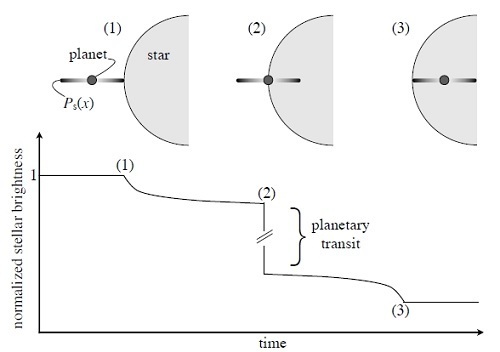
Image: This figure from Heller’s paper depicts the effects of a transiting exoplanet with exomoon averaged over time. We would expect a drop in starlight as the exoplanet moves in front of the host star, but Heller’s method focuses on the change to the lightcurve caused by the exomoon before and after it crosses the stellar disk, an effect which repeats on the other side. Credit: René Heller.
The ‘stacking up’ effect of these transit observations over time as the moon and planet transit the star in different configurations allows the detection. Because we need plentiful statistical data to make all this work, red dwarf stars are ideal candidates because habitable zone planets there have extremely short years and thus make many transits. According to Heller, moons down to Ganymede size should be detectable around M-dwarfs, while around warmer orange dwarf stars, exomoons about ten times Ganymede’s mass would be within range. G-class stars like the Sun are not represented well enough in the Kepler data because they lack sufficient transits.
The minute effects discernible in an exoplanet’s regular transit are what make the exomoon detection possible. Heller notes that the Orbital Sampling Effect (OSE) yields data indicative of the moons’ radii and planetary distances, while study of the planet’s transit timing variations (TTV) and transit duration variations (TDV), in conjunction with Orbital Sampling Effect, allow measurements of the moon’s mass. More complex transit signatures could, using this method, even allow the detection of multiple exomoon candidates.
The paper is Heller, “Detecting extrasolar moons akin to solar system satellites with an orbital sampling effect,” The Astrophysical Journal, Vol. 787, No. 1 (2014), abstract and preprint available. Thanks to Dave Moore for the pointer to this work.






May 20, 2014
A New Marker for Planet Formation
Given how many planet-hosting stars we’re finding, any markers that can tell us which are most likely to have terrestrial worlds would be welcome. New work out of Vanderbilt University is now providing us with an interesting possibility. Working with the university’s Keivan Stassun, graduate student Trey Mack has developed a model that studies the chemical composition of a given star and relates it to the amount of rocky material it has ingested during the course of its lifetime. Stars with a high amount of such material may be places where small, terrestrial worlds are rare.
What Mack has done is to look at the relative abundance of fifteen specific elements. According to this Vanderbilt news release, he was most interested in elements with high condensation temperatures like aluminum, silicon, calcium and iron, the kind of materials that become building blocks for planets like the Earth. In this context, it’s important to remember that stars are 98 percent hydrogen and helium, with all elements heavier than these being referred to as ‘metals.’
Bear in mind how stellar metallicity may be affected during planet formation, as discussed in the paper:
There are at least two planet formation processes that may alter stellar surface abundances: (1) the accretion of hydrogen-depleted rocky material (Gonzalez, 1997), which would result in the enrichment of the stellar atmosphere, and (2) H-depleted rocky material in terrestrial planets may be withheld from the star during their formation, which would result in the depletion of heavy elements relative to H in the stellar atmosphere (Melendez et al. 2009).
All of this can lead to scenarios involving planetary migration:
For the enrichment scenario, Schuler et al. (2011a) suggest that stars with close-in giant planets (∼0.05 AU) may be more enriched with elements of high condensation temperature (TC). This is thought to be a result of giant planets which form in the outer planetary system migrating inward to their present close-in positions. As they migrate, they can push rocky material into the host star (e.g., Ida & Lin 2008; Raymond et al. 2011). For the depletion scenario, Melendez et al. (2009) and Ramırez et al. (2009) propose that the depletion of refractory elements in Sun-like stars may correlate with the presence of terrestrial planets.
For the Vanderbilt work, the wide binary pair HD 20782/81 proved a useful study, chosen by Mack because both stars have planets and both evidently condensed out of the same cloud of dust and gas, thereby beginning their lives with the same chemical compositions. To my knowledge, this is the only known wide binary in which both stars host detected planets. The two stars are G-class dwarfs like the Sun, one being orbited by two Neptune-class planets, the other by a single Jupiter-size world in a highly eccentric orbit. The spectra of the stars indicates that both show an abundance of refractory materials significantly higher than the Sun.
The abundances of these metals is high enough, in fact, to indicate that each of the two stars would have had to consume an amount of rocky material equal to 10-20 Earth masses to produce the observed spectra. On that score it is significant that both stars host giant planets on eccentric orbits closing as tightly as 0.2 AU. Mack summarizes the finding:
“Imagine that the star originally formed rocky planets like Earth. Further, imagine that it also formed gas giant planets like Jupiter. The rocky planets form in the region close to the star where it is hot and the gas giants form in the outer part of the planetary system where it is cold. However, once the gas giants are fully formed, they begin to migrate inward and, as they do, their gravity begins to pull and tug on the inner rocky planets. With the right amount of pulling and tugging, a gas giant can easily force a rocky planet to plunge into the star. If enough rocky planets fall into the star, they will stamp it with a particular chemical signature that we can detect.”
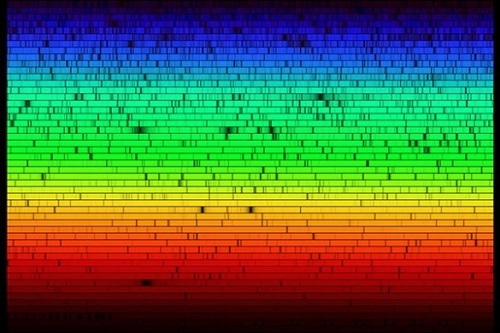
Image: What if we could determine if a given star is likely to host a planetary system like our own by breaking down its light into a single high-resolution spectrum and analyzing it? A spectrum taken of the Sun is shown above. The dark bands result from specific chemical elements in the star’s outer layer, like hydrogen or iron, absorbing specific frequencies of light. By carefully measuring the width of each dark band, astronomers can determine just how much hydrogen, iron, calcium and other elements are present in a distant star. The new model suggests that a G-class star with levels of refractory elements like aluminum, silicon and iron significantly higher than those in the Sun may not have any Earth-like planets because it has swallowed them. Credit: N.A.Sharp, NOAO/NSO/Kitt Peak FTS/AURA/NSF.
With this in mind, the possibility that either of the binary twins hosts terrestrial planets is sharply reduced. The star orbited by two Neptune-class planets seems to have ingested more rocky material than its twin, with Mack and Stassun speculating that the two planets proved to be more efficient orbital disruptors for any terrestrial worlds that may have once been there. Even so, the other star, orbited by a Jupiter-class world, evidently pushed a large amount of rocky material into its star as well. The chemical composition is telling us that G-class stars with such high metallicities probably lack the kind of inner rocky planets many astronomers are searching for.
If these signatures are born out by subsequent study, we may have found a way to quickly determine whether a given G-class star is likely to have terrestrial planets, simply by analyzing its chemical composition. Several previous studies have linked star metallicity with planet formation, with one concluding that gas giants are found around high-metallicity stars, while terrestrial planets can be found around stars with a wide range of metal content. This work extends the use of metals as a marker in interesting new directions, playing off the link between a G-class star’s chemical composition and the kind of solar system it is likely to produce.
The paper is Mack et al., “Detailed Abundances of Planet-Hosting Wide Binaries. I. Did Planet Formation Imprint Chemical Signatures in the Atmospheres of HD 20782/81?” The Astrophysical Journal Vol. 787, No. 2 (2014), p. 98 (abstract / preprint).






May 19, 2014
GU Piscium b: Tuning Up our Imaging
How do you go about characterizing a directly imaged planet around another star? In the absence of a transit, one way is to apply theoretical models of planetary formation and evolution to the light spectrum you’re working with. When a team of researchers led by Marie-Ève Naud (a graduate student at the Université de Montréal) used these methods on direct imaging data from four different observatories to characterize a planet 155 light years from the Earth, they arrived at a temperature of some 800 degrees Celsius. The work drew inferences based upon the location of the newly detected world. For the planet, GU Piscium b, orbits a star that is a member of the AB Doradus moving group, some 30 stars that move together with the star AB Doradus.
The AB Doradus association is helpful because a moving group is made up of stars of roughly the same age and metallicity, a sign they probably formed in the same location. The fact that these are young stars, perhaps 100 million years old, also helped the team pull together an estimate of the planet’s mass, some 9 to 13 times that of Jupiter. The striking thing about GU Piscium b is that it orbits at about 2000 AU, the farthest exoplanet from its host that I am aware of. A single trip around its star would take GU Piscium b some 80,000 years. That distance makes infrared detection possible, particularly since young planets like this are still cooling and are therefore brighter.
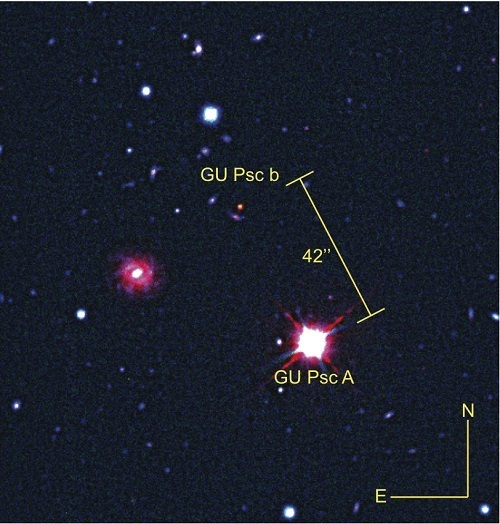
Image: The planet GU Piscium b and its star GU Piscium. This image is composed of visible and infrared images from the Gemini South telescope and an infrared image from the CFHT. Because infrared light is invisible to the naked eye, astronomers use a color code in which infrared light is represented by the color red. GU Piscium b is brighter in infrared than in other filters, which is why it appears red in this image. Credit: Gemini Observatory/OMM/CFHT/W.M. Keck Observatory.
René Doyon, director of the Observatoire Mont-Mégantic (OMM) some 200 kilometers east of Montreal, calls GU Piscium b “a true gift of nature,” noting that its large distance from the star means a number of instruments can study it in depth, including smaller telescopes like the one at OMM. In this case, the work also involved the Gemini Observatory, the Canada-France-Hawaii Telescope (CFHT) and the W.M. Keck Observatory, whose combined resources produced images at a variety of wavelengths. Having such a clearly defined object for direct imaging studies should be helpful as we work on imaging planets closer to their stars.
On that score, a nod to the debut of the Gemini Planet Imager (GPI), whose first image produced the high-quality result shown below. This is Beta Pictoris b, some 63 light years from Earth, seen through a single 60-second exposure. The GPI’s advanced optics can detect planets down to Jupiter size orbiting stars similar to the Sun, whereas the previous generation of adaptive optics could image planets no smaller than three times Jupiter’s mass, and only planets as far from their star as Saturn or Neptune is from the Sun.
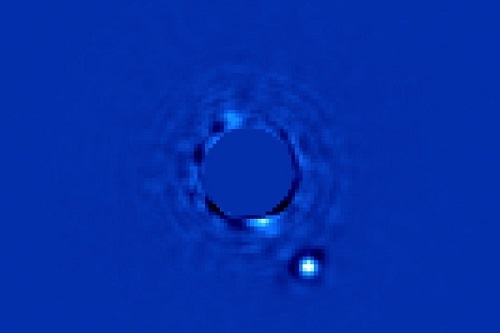
Image: The bright white dot is the planet Beta Pictoris b, glowing in the infrared light from the heat released when it was formed 10 million years ago. The bright star Beta Pictoris is hidden behind a mask at the center of the image. (Image processing by Christian Marois, NRC Canada).
So we’ve had only a few planets directly imaged, but we’re making progress. Enough so that Bruce Macintosh, principal investigator on the GPI project, predicts in the team’s paper on this work that the planet may transit the host star in 2017, based on information gleaned from the GPI dataset, which yielded clues to the planet’s orbit. A transit of a directly imaged planet would open up in-depth investigation of the planet’s characteristics — remember that Kepler, although it has found thousands of transiting worlds, cannot produce direct imagery of any of them.
And no, not even the Gemini Planet Imager, in operation since November at its site in Chile, will let us see planets as small as the Earth. But Macintosh sees a continued and positive evolution in our capabilities. “…[I]t’s a step on the road,” he added. “Some day a future space telescope will use the same technology, and be able to see an Earth around one of these nearby stars.”
The Beta Pictoris b paper is Macintosh et al., “First light of the Gemini Planet Imager,” published online by Proceedings of the National Academy of Sciences (abstract). The GU Piscium b paper is Naud et al., “Discovery of a Wide Planetary-Mass Companion to the Young M3 Star GU Psc,” The Astrophysical Journal Vol. 787, No. 1 (2014). Abstract and preprint available.






May 12, 2014
Time Out
Over the past months, enough projects have piled up in need of attention that I finally have to decide to get serious about them. That means a short break here. No Centauri Dreams posts this week, therefore, with publication resuming next week on Monday or Tuesday. While I’m putting various things — some space-related, some not — in order, I’ll try to keep up with comment moderation, though it may get sporadic for a time. Meanwhile, do keep plugging into Heath Rezabek’s book survey as we try to isolate not only what books from my shortlist are the most useful, but also search for books you think should be on the list. Please add any titles you think worthwhile in the space provided on the survey form. I look forward to watching this survey grow, and to Heath’s reflections on it once it has grown to sufficient size. See you in a week.






May 9, 2014
An Emerging Interstellar Bibliography
Today begins Heath Rezabek’s survey as we look at the curation of a booklist on interstellar flight, using as basis a list of books I’ve gradually accumulated over the years. Before Heath introduces the survey, a few words about my methods: Many of the books listed below are ones that I used in preparing my 2005 book Centauri Dreams: Imagining and Planning Interstellar Exploration. But in the time since, I’ve added a number of more recent titles. I’m hoping this curation project will reveal other books that may be useful as we flesh out the list. Please glance over the entire list and be thinking of additional possibilities as you engage with Heath’s survey.
As to the choices made, these are non-fiction science books, although several recent titles contain a mix of non-fiction and science fiction stories. Feel free to suggest SF titles that specifically broaden our thinking about interstellar flight — we can either integrate them into the main list or develop a second list focused on fiction. The latter may be more practicable. Also, books on SETI and exoplanetology are under-represented in favor of books on spaceflight and propulsion. Given how often we discuss these matters on Centauri Dreams. I’d like to see recommendations for more titles in both these areas.
I also restricted the selection to books that have been through serious peer review from the publisher itself or qualified people chosen by its editors. Books that largely compile previously published papers that have been through rigorous peer review also make the list. While self-publishing is a growing phenomenon, if no peer review is evident, I cannot add such titles to the short list. With that in mind, let’s see what happens as Heath’s work develops.
by Heath Rezabek

In yesterday’s entry, I summarize my work to this point as an Intern with the Long Now Foundation, assisting and advising on the community curation of the Manual for Civilization collection.
In today’s entry, we’ll undertake our own experiment in community curation, by asking the readers of Centauri Dreams to compare the books in Paul Gilster’s Centauri Dreams shortlist, and most importantly, to recommend titles which you don’t see represented but which you feel are integral to the themes explored here over time. We’ll end up with two resources which Paul can use in the future: The list itself, and the relative rankings based on community comparison of titles’ relative importance to a core Centauri Dreams community collection.
In the Centauri Dreams Vessel Survey (link immediately below), participants are encouraged to add as many titles as they wish — particularly newer or older titles not yet reflected — and sort between titles as often as they like. Over time, we’ll end up with our own wish list for a core collection reflecting the Centauri Dreams readership community.
This survey tool works a bit differently from other surveys you might have taken, but may be familiar if you’ve run across our use of it here before. At the link below, your task to complete as many times as you wish to weigh in is simply to pick between two titles from the list in any given round.
Once you’ve picked one as more integral than the other, another pairing will come up. You are encouraged to sort between titles as many times as you can, as the more data such a survey has, the more useful its results. You may stop when you’re weary, and return later if you wish.
You are also greatly encouraged to add related titles, items which have informed your thinking on these themes as a member of the Centauri Dreams community of readers. Duplicates are not much of a problem, as they cluster over time and we can deactivate them once they do. Again, the more data, the better the results. Click on the image or the link below it to participate in the survey.
Centauri Dreams Vessel Survey: Community Curation
We will revisit this survey as time passes, as votes accrue, and as titles are added.
Thank you, Paul, for giving the nod to try community curation on Centauri Dreams; thank you, readers of Centauri Dreams, for lending your voice as community members.
Paul’s original list is below, though because of character limits in the surveys, annotations and publisher details are not always included in the survey version.
[PG note: The breakdown of my list into General Audience, College, Graduate and Professional was an attempt at sorting that I’ve grown uncomfortable with -- many of these titles could go in more than one such category. So don’t let the categories concern you at this point].
General Audience
Adler, Charles (2014) Wizards, Aliens and Starships. Princeton, NJ: Princeton University Press.
Caleb Scharf calls this “…a delightful, funny, and immensely interesting romp through science and fiction,” which precisely nails the spirit of the book. Adler looks at the wonders of science fiction from alien civilizations to teleportation and warp drive, framing the discussion against judiciously explained physics. It’s hugely entertaining and scientifically sound.
Berry, Adrian (2000) The Giant Leap: Mankind Heads for the Stars. New Yorks: Tor Books.
A look at the technologies that might one day lead to the nearest stars and beyond. Discusses the options for making such journeys, along with the political and philosophical imperatives that might drive such a mission. Interesting chapters on interstellar navigation and suspended animation.
Boyce, Christopher (1979) Extraterrestrial Encounter: A Personal Perspective. Secaucus, NJ: Chartwell Books.
Speculations on the nature of alien intelligence and the possibilities for understanding and communicating with it. The odds on SETI and the possible use of Bracewell or von Neumann robotic probes for studying other planets play a role in this lively discussion.
Burrows, William E. Exploring Space: Voyages in the Solar System and Beyond. New York: Random House, 1990.
One of the best histories of the space program ever written, this book gives full weight to automated probes rather than manned flight, and speculates on the technologies that will take us outside the Solar System. Burrows’ look at the politics behind programs like the Space Shuttle resonates today.
Calder, Nigel (1978) Spaceships of the Mind. New York: Viking Press.
Speculations on space technologies including many interstellar concepts. Numerous useful though dated illustrations. The driving factors pushing space colonization are carefully examined.
Forward, Robert L (1995) Indistinguishable from Magic. New York: Baen Books.
Perhaps the greatest interstellar theorist of them all, Robert Forward offered mission concepts galore in the course of his career, many of them entertainingly discussed in this collection of essays. The author’s wry humor often shows through in discussions that range from wormholes to antimatter engines.
Friedman, Louis (1988) Starsailing: Solar Sails and Interstellar Travel. New York: John Wiley & Sons.
Friedman’s background working at the Jet Propulsion Laboratory on a once-considered solar sail mission to Halley’s Comet allows him to tap deep resources in explaining how solar sails will one day open up the Solar System, with potential for interstellar flight via particle or laser beam.
Kaku, Michio (2008) Physics of the Impossible: A Scientific Exploration into the World of Phasers, Force Fields, Teleportation, and Time Travel. New York: Doubleday.
Kaku discusses three levels of ‘impossibility,’ ranging from things we may one day puzzle out to technologies that would strike us as indistinguishable from magic, to use Arthur Clarke’s fine phrase. This wide-ranging study includes a look at interstellar technologies now under active study.
Krauss, Lawrence (1995) The Physics of Star Trek. New York: Basic Books.
A theoretical physicist offers thoughts on the scientific wonders of the popular TV series, discussing such issues as teleportation, time travel, warp drive and black holes. Excellent at untangling the futuristic but possible from the hugely improbable, based on known physics.
Macvey, John W. (1977, 1991) Interstellar Travel: Past, Present and Future. New York: Stein and Day.
Revised in 1991, this book examines interstellar travel technologies ranging from space arks to wormholes, with a long discussion of the nature of extraterrestrial life and how it might communicate with humans. Wide-ranging and easy to read, this is a good choice for young readers.
Myrabo, Leik and Dean Ing (1985) The Future of Flight. New York: Baen Books.
Starship drives are only one of the topics covered by this survey of future flight technologies, but the interstellar chapter is strong, surveying concepts from the Bussard ramjet to the laser-driven lightsail and antimatter engines. A good though now backgrounder for those wanting a quick survey of these ideas.
Nicholson, Iain (1978) The Road to the Stars. New York: William Morrow & Co.
A well-illustrated and lively survey of future space technologies, with a useful discussion of SETI and the possibilities of communicating with extraterrestrial intelligence. The major ideas for upgrading today’s engines are presented, beginning with ion drives and carrying forward to the Bussard ramjet.
Sagan, Carl (1980) Cosmos. New York: Random House.
Carl Sagan’s classic offers some of the most captivating illustrations ever made available in a space book. While the book, like the TV series it parallels, offers perspective on the entire human experience of the heavens, it places the possibilities of interstellar flight in a readable, powerful context.
Wright, Jerome L. (1992) Space Sailing. New York: Taylor & Francis.
A history of the solar sail concept, one that uses momentum from the Sun’s own light to drive a space vehicle, without the need to carry heavy fuel. Well illustrated, this book examines all the ways solar sails may change our future in space, both in the near term and the far.
College Level
Adelman, Saul J. and Benjamin Adelman (1981). Bound for the Stars: Space Travel in our Solar System and Beyond. Inglewood Cliffs, NJ: Prentice-Hall.
The exploration of space from travel in the nearby Solar System to interstellar missions. The latter chapters discuss interstellar propulsion, navigation, the search for extrasolar planets and the first starship. Useful discussions as well about a plausible program for long-term interstellar planning.
Andreadis, Athena (1999) To Seek Out New Life: The Biology of Star Trek. New York: Three Rivers Press. A professional biologist goes to work on life sciences as depicted in Star Trek, with thoughts on everything from telepathy and the genetic code to the cultural sameness of the societies the Enterprise’s crew encounters. Entertaining and instructive.
Benford, Gregory and James (2013) Starship Century. Lucky Bat Books.
Starship Century is an anthology by authors from both science and fiction writing backgrounds, illustrating some of the tech and ideology behind the illustrious goal of traveling to another star within the next century. Edited by Gregory Benford, New York Times bestselling science fiction author, and James Benford, leading expert on space propulsion, Starship Century includes science fiction by Neal Stephenson, David Brin, Joe Haldeman, Nancy Kress, Stephen Baxter, Gregory Benford, John Cramer, Richard A. Lovett, and Allen Steele, as well as scientific articles by Stephen Hawking, Freeman Dyson, Robert Zubrin, Peter Schwartz, Martin Rees, Ian Crawford, James Benford, Geoffrey Landis, Paul Davies and Adam Crowl.
Billings, Lee (2013) Five Billion Years of Solitude. New York: Current.
The exoplanet hunt as seen through Lee Billings’ eyes as he interviews the major players in the field, from Frank Drake to Jim Kasting, Sara Seager, Greg Laughlin, Geoff Marcy and more. Within their individual stories Billings weaves in the technological and science breakthroughs that have made current work possible, and points eloquently toward the next stages in the journey as we look for a genuine Earth. 2.0. There is no better examination of the basic techniques and issues surrounding exoplanet detection and the human impact of this work.
Clarke, Arthur C. and David Brin, ed. (1990) Project Solar Sail. New York: Roc.
Useful essays from leading theorists examine the role of solar sails in future space missions, with attention to missions in the Solar System and beyond. The essays are interleaved with short fiction and even poetry that explores plausible scenarios for putting sails to work.
Dole, Stephen H. and Isaac Asimov (1964) Planets for Man. New York: Random House.
This is the popular version of a RAND Corporation study originally performed by Dole. The later version includes the thoughts of Isaac Asimov, and examines the factors necessary for planets to be habitable for humans, and our chances of finding them. Although dated, this book still offers useful information about the concept of a habitable zone and the factors that will one day make particular planets useful destinations for our probes.
Dyson, George (2002) Project Orion: The True Story of the Atomic Spaceship. New York: Henry Holt and Co.
Freeman Dyson’s son tackles the great attempt to wed nuclear technology to deep space missions, Project Orion. Told with flair and access not only to key documents but the recollections of the major players, this history shows how one team of experts viewed journeys to the outer Solar System and beyond before the realities of the Test Ban Treaty put the concept beyond reach.
Forward, Robert L. and Joel Davis (1988) Mirror Matter: Pioneering Antimatter Physics. New York: John Wiley & Sons.
Interstellar theorist Robert Forward offers a thorough background to the history of antimatter research. Propulsion concepts that could drive our first starships are examined, while the methods for creating and storing antimatter and using it here on Earth receive solid scrutiny. The chapter on antimatter in science fiction is particularly energetic.
Genta, Giancarlo (2007) Lonely Minds in the Universe. Berlin: Springer.
A valuable study of astrobiology and the search for extraterrestrial intelligence, unique in the extent to which it explores the philosophical and religious background of humanity’s awakening interest in the cosmos. The discussion of biology both on Earth and elsewhere offers insights into the possibilities of living organisms around other stars, while the author’s speculations about consciousness and intelligence remind us just how unique each alien ecosystem and its inhabitants may be. How we may interact with any intelligence we discover forms an insightful part of the narrative.
Gilster, Paul (2004) Centauri Dreams: Imagining and Planning Interstellar Exploration. New York: Copernicus Books.
Surveys methods for moving an interstellar probe to speeds that could reach nearby stars in a single human lifetime. These range from fusion to antimatter, beamed lightsails, magnetic sails, Bussard ramjets and other concepts. Also covers interstellar navigation and exoplanet detection.
Grinspoon, David (2003) Lonely Planets. New York: Ecco.
I found this a useful and deeply entertaining overview of current and historical thinking on extraterrestrial life, with interesting arguments against the hypothesis that the Earth is in any way unique when it comes to the ability to produce living organisms. What intelligent life might become both on Earth and elsewhere is considered with a leavening of personal anecdotes and humor, and a plea that we move beyond definitions of life too firmly attached to our own planet.
Impey, Chris and Holly Henry (2014) Dreams of Other Worlds. Princeton, NJ: Princeton University Press.
Read Impey and Henry for an overview of where we’re coming from in unmanned space exploration and robotics. The book lays out our explorations from Viking on Mars to Cassini, WMAP and Spitzer, chronicling the interplay of new technologies and emerging science. Manned missions invariably get more buzz, but until we ramp up our methods, the outer system belongs to increasingly sophisticated machines. This is where they come from.
Johnson, Les and Jack McDevitt, eds. (2012) Going Interstellar. New York: Baen.
A collection of tales by an all-star assortment of award winning authors including Ben Bova, Mike Resnick, Jack McDevitt, Michael Bishop, Sarah Hoyt and more together with essays on high technology by space scientists and engineers – all taking on new methods of star travel. The essays include reports on propulsion technologies including antimatter, solar sails and fusion. The science fiction speculations tackle the human consequences of travel to another star and how our descendants will master issues from species survival to alien contact.
Kaku, Michio (1995) Hyperspace: A Scientific Odyssey Through Parallel Universes, Time Warps and the Tenth Dimension. Oxford University Press.
Understanding the possibilities of interstellar flight demands a look at the things that may warp space and time, including wormholes that could offer fast transit without exceeding the speed of light. Michio Kaku explains the options with a minimum of jargon and clear, readable prose.
Mallove, Eugene F., and Gregory L. Matloff (1989) The Starflight Handbook: A Pioneer’s Guide to Interstellar Travel. New York: John Wiley.& Sons.
A classic of interstellar studies, Matloff and Mallove’s book provides the necessary theory to understand the various propulsion methods proposed to reach the stars. All major concepts are considered by two authors who have been involved in interstellar concepts for decades.
Matloff, Gregory, Les Johnson and C. Bangs (2007) Living Off the Land in Space: Green Roads to the Cosmos. New York: John Wiley & Sons.
Space travel as we do it today requires large amounts of fuel that take up a major part of the rockets we launch. How we can learn to use resources in space itself may determine how soon we push into the outer Solar System and beyond. The science behind space tethers, solar sails and other techniques for in-System voyaging are here explored, along with speculations about even more audacious concepts that could take us to the stars.
Matloff, Gregory, Les Johnson and Giovanni Vulpetti (2010) Solar Sails: A Novel Approach to Interplanetary Travel. Berlin: Springer. A comprehensive survey of solar sail concepts ranging from near-term designs like the Solar Polar Imager to interstellar possibilities enabled by laser-driven lightsails, this book summarizes our sail knowledge at the beginning of the solar sail era, with numerous thoughts on sail design, construction, deployment and trajectories.
Michaud, Michael (2006) Contact with Alien Civilizations: Our Hopes and Fears about Encountering Extraterrestrials. New York: Copernicus.
A thorough discussion of the consequences of our encounters with extraterrestrial civilizations, with background studies of the history of human speculation about extraterrestrial intelligence, our searches for life and for the signals of other cultures, and the various ways contact might play out. In an era when some are trying to extend the SETI (listening) paradigm to METI (broadcasting), this book offers sober analysis of how humanity should weigh these options, and opts for multidisciplinary negotiation and consensus before acting in ways that could impact the entire species.
Savage, Marshall T. (1994) The Millennial Project: Colonizing the Galaxy in Eight Easy Steps. New York: Little, Brown & Co.
An optimistic look at how mankind can spread into the cosmos, offering a program to transfer a large proportion of the world’s population into venues off-planet. Step by step improvements lead to terraforming Mars, using the resources of the outer system, and moving to the nearby stars.
Strong, James (1965) Flight to the Stars. New York: Hart Publishing Company.
An early classic of interstellar studies, Strong’s book offers a rationale for the human expansion to the stars, while considering a variety of propulsion concepts to get the job done. While dated in specifics, the scenarios considered here paint possible futures for a star-faring race with vigor and enthusiasm.
Thorne, Kip S. (1994) Black Holes and Time Warps: Einstein’s Outrageous Legacy. New York: W.W. Norton & Co.
Thorne is a major player in the theory of wormholes, and thus the kind of distortions of spacetime that may one day make it possible to travel vast distances quickly without ever exceeding the speed of light. This book places his theories into the Einsteinian context in readable if challenging fashion.
Zubrin, Robert (1999) Entering Space: Creating a Spacefaring Civilization. New York: Tarcher/Putnam, 1999.
The case for becoming a spacefaring civilization is made with enthusiasm and panache. The action ranges from terraforming nearby Mars to exploiting the resources of the outer planets, with solid chapters on interstellar propulsion and contact with extraterrestrial civilizations.
Graduate/Professional Level
Carroll, Michael (2011) Drifting on Alien Winds: Exploring the Skies and Weather of Other Worlds. New York: Springer.
From the Soviet Venus balloons to the advanced studies of blimps and airplanes for the atmospheres of Mars and Titan, Drifting on Alien Winds surveys the many creative and often wacky ideas for exploring alien skies. Through historical photographs and stunning original paintings by the author, readers also explore the weather on planets and moons, from the simmering acid-laden winds of Venus to liquid methane-soaked skies of Titan.
Czysz, Paul and Claudio Bruno (2009) Future Spacecraft Propulsion Systems: Enabling Technologies for Space Exploration. Berlin: Springer.
Space propulsion systems from near-Earth to the outer Solar System and beyond. Focus on applied engineering working within the known principles of physics, with emphasis on fusion rocket designs and the extension of today’s technologies to missions into deep space.
Doody, Dave (2009) Deep Space Craft: An Overview of Interplanetary Flight. Berlin: Springer.
Descriptions of interplanetary spacecraft with detailed looks at their instrumentation and the Earth-based operations needed to acquire and process their incoming data. Flight operations and the interactions between a mission’s science team and the light team are examined, with detailed appendices on the range of instruments that have so far flown, and those likely to be aboard spacecraft in the future.
Finney, Ben R. and Eric M. Jones (1985) Interstellar Migration and the Human Experience. Berkeley: University of California Press.
This is a compilation of papers from the Conference on Interstellar Migration held at Los Alamos in May of 1983, which examined not only the scientific possibilities, but also the social, ethical and even legal ramifications of our move into the cosmos. Its look at how humanity has coped with past challenges, such as the settlement of the Pacific islands, places interstellar migration in context.
Kondo,Yoji, ed. (2003) Interstellar Travel and Multi-Generational Space Ships. Apogee Books Space Series 34. Collector’s Guide Publishing Inc (June 1, 2003).
Papers from a symposium of the American Association for the Advancement of Science in 2002, exploring propulsion concepts and the solutions needed for flight to the stars. The book also addresses the cultural and psychological issues related to long-term voyaging and ponders ‘generation ships,’ in which crew members spend their entire lives on voyages several centuries in duration.
Long, Kelvin (2011) Deep Space Propulsion. New York: Springer.
The technology of the next few decades could possibly allow us to explore with robotic probes the closest stars outside our Solar System, and maybe even observe some of the recently discovered planets circling these stars. This book looks at the reasons for exploring our stellar neighbors and at the technologies we are developing to build space probes that can traverse the enormous distances between the stars. All the propulsion concepts seriously considered for interstellar flight are examined here.
Maccone, Claudio (2009) Deep Space Flight and Communications: Exploiting the Sun as a Gravitational Lens. Berlin: Springer.
Maccone has long been the champion of a mission to the Sun’s gravitational lens at 550 AU and beyond. Here he lays out the results of his two decades of study of the concept, discussing possible probe designs, the best targets for investigation, and the underlying principles of lensing. Section 2 examines the challenge of communicating between an interstellar spacecraft and the Earth, focusing on the opportunities found in the Karhunen-Loève Transform (KLT) for optimal telecommunications.
Matloff, Gregory L. (2005) Deep Space Probes: To the Outer Solar System and Beyond. Berlin: Springer/Praxis Books.
Recently revised, Matloff’s look at deep space technologies offers abundant references in its examination of current theories of interstellar propulsion, including nanotechnology and ramscoops that draw their fuel from hydrogen between the stars. Also included are speculations on astrobiology and the development of self-reproducing von Neumann probes that could saturate the galaxy.
Mauldin, John H. (1992) Prospects for Interstellar Travel. American Astronautical Society Science and Technology Series, Vol. 80. San Diego, CA: Univelt.
A thorough study of interstellar flight possibilities that covers, in addition to the relevant propulsion concepts, every aspect of starship design, including the navigation problem and the difficulties posed by lengthy voyages with human crews. The overall engineering of space probes designed for such missions is discussed at length, with abundant references for follow-up reading.
McInnes, Colin R. (1999) Solar Sailing: Technology, Dynamics and Mission Applications. Chichester, UK: Praxis Publishing.
The most exhaustive study of solar sail technology available, offering a rich list of references for specialists. Applications for near-term missions are considered in detail, with the relevant equations for understanding the forces at work. A thorough examination of sail materials and design explains where we are now and how solar sails may change the economics of propulsion. Beamed lightsails for interstellar missions.
Millis, Marc and Eric Davis, eds. (2009). Frontiers of Propulsion Science. Reston, VA: AIAA.
A compilation of essays from specialists about the prospects for breakthroughs that could revolutionize spaceflight and enable interstellar flight. Five major sections are included in the book: Understanding the Problem lays the groundwork for the technical details to follow; Propulsion Without Rockets discusses space drives and gravity control, both in general terms and with specific examples; Faster-Than-Light Travel starts with a review of the known relativistic limits, followed by the faster-than-light implications from both general relativity and quantum physics; Energy Considerations deals with spacecraft power systems and summarizes the limits of technology based on accrued science; and, From This Point Forward offers suggestions for how to manage and conduct research on such visionary topics.
Seedhouse, Erik (2012) Interplanetary Outpost: The Human and Technological Challenges of Exploring the Outer Planets. New York: Springer/Praxis.
Interplanetary Outpost follows the mission architecture template of NASA’s plan for Human Outer Planet Exploration (HOPE), which envisions sending a crew to the moon Callisto to conduct exploration and sample return activities. To realize such a mission, the spacecraft will be the most complex interplanetary vehicle ever built, representing the best technical efforts of several nations. A wealth of new technologies will need to be developed, including new propulsion systems, hibernation strategies, and revolutionary radiation shielding materials. Step by step, the book will describe how the mission architecture will evolve, how crews will be selected and trained, and what the mission will entail from launch to landing.
Smith, Cameron (2012) Emigrating Beyond Earth: Human Adaptation and Space Colonization. New York: Springer.
Based on the most current understanding of our universe, human adaptation and evolution, the authors explain why space colonization must be planned as an adaptation to, rather than the conquest of, space. Emigrating Beyond Earth argues that space colonization is an insurance policy for our species, and that it isn’t about rockets and robots, it’s about humans doing what we’ve been doing for four million years: finding new places and new ways to live. Applying a unique anthropological approach, the authors outline a framework for continued human space exploration and offer a glimpse of a possible human future involving interstellar travel and settlement of worlds beyond our own.
Vakoch, Douglas and Albert Harrison, eds. (2013) Civilizations Beyond Earth: Extraterrestrial Life and Society. Berghahn Books.
This collection of essays takes in the search for extraterrestrial intelligence and offers a sociological and philosophical entry into a field that is often dominated by the hard sciences. Vakoch, a sociologist, brings a useful new dimension to the question of how humanity would react to extraterrestrial contact, and the essays chosen for this volume form a discussion that meshes well with Michael Michaud’s work in Contact with Alien Civilizations. Harrison, a psychologist from the University of California, helps to ensure that SETI analysis will continue to deepen its multidisciplinary links as the field evolves.
Woodward, James (2012) Making Starships and Stargates: The Science of Interstellar Transport and Absurdly Benign Wormholes. New York: Springer/Praxis.
A study in three parts: The first deals with information about the theories of relativity needed to understand the predictions of the effects that make possible the “propulsion” techniques, and an explanation of those techniques. The second deals with experimental investigations into the feasibility of the predicted effects; that is, do the effects exist and can they be applied to propulsion? The third part of the book – the most speculative – examine the questions: what physics is needed if we are to make wormholes and warp drives? Is such physics plausible?






Paul Gilster's Blog
- Paul Gilster's profile
- 7 followers




